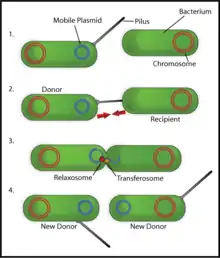Mating bridge
A mating bridge, also known as a "conjugation bridge", is a connection between two bacterial cells that provides a passageway for DNA in bacterial conjugation.

Bacterial Conjugation. Note that the sex pilus is a structure on the F+ cell whereas the mating bridge (not labeled) is the connection between the two bacteria.
A mating bridge is different from a sex pilus, which is a structure made by an F+ strain bacterium in bacterial conjugation. The pili (plural) act as attachment sites that promote the binding of bacteria to each other. In this way, an F+ strain makes physical contact with an F− strain. Once contact is made, the pili shorten and thereby draw the donor and recipient cells closer together. A conjugation bridge is then formed between the two cells, which provides a passageway for DNA transfer.[1]
References
- Brooker, Robert J (2012). Genetics: Analysis and Principles. 1221 Avenue of the Americas, New York, NY 10020: Janice Roerig-Blong. pp. 164, 165, G-4. ISBN 9780073525280.CS1 maint: location (link)
This article is issued from Wikipedia. The text is licensed under Creative Commons - Attribution - Sharealike. Additional terms may apply for the media files.